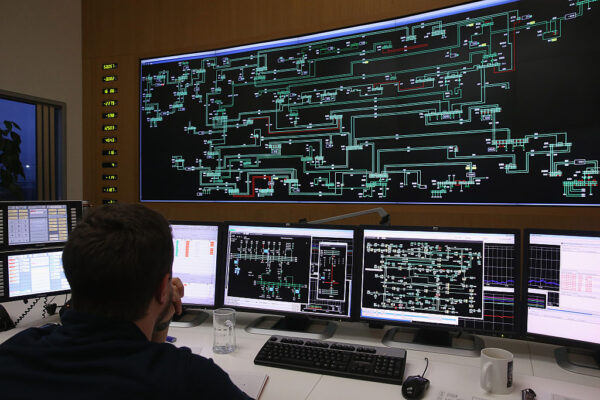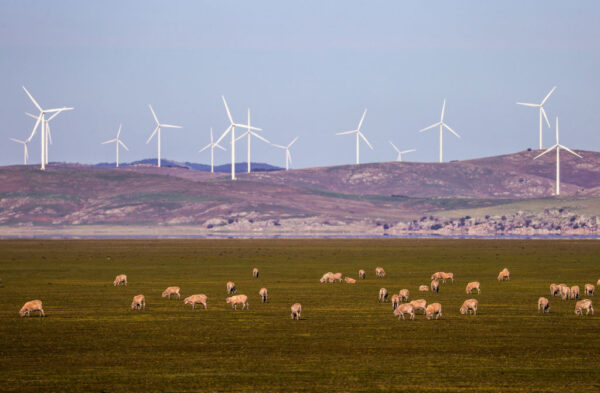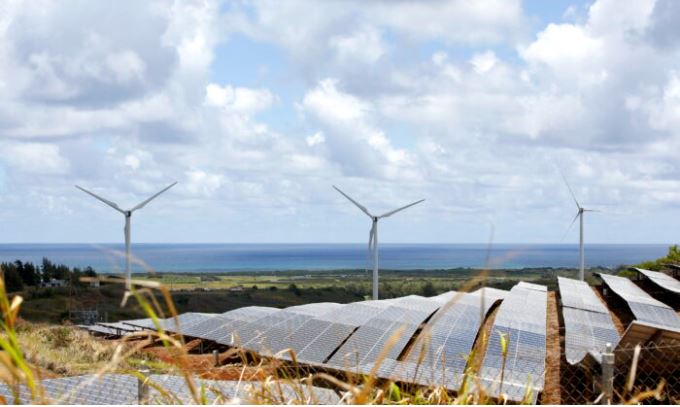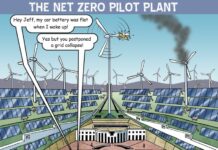Peter Castle
The Renewable Energy Problem That No One Talks About
An obvious barrier to adopting wind and solar power for electricity supply is their intermittency—when the wind isn’t blowing, and the sun isn’t shining, substitute sources are required. This issue is given much attention by conservative media, as it should.
Yet one of the less well-known roadblocks for these renewable technologies is frequency control, even though it becomes a critical concern much sooner.
Since the 1890s, electricity networks and devices all around the globe have used alternating current (AC) systems, which means that the flow of electricity in the system is repeatedly changing direction.
In Australia, it alternates 50 times a second, that is, at a frequency of 50 Hertz (in the USA, it is 60 Hertz).
Supplying electricity at a consistent frequency is very important because appliances and electronics on the network are designed for a specific frequency/voltage input. Therefore, they can be damaged by the wrong electricity supply.
As a rule, networks would rather supply no electricity than bad electricity. Automated controls through the electricity system will disconnect the supply if the frequency or voltage is “off-spec.”

South Australians will not soon forget when this happened to the entire state network in 2016. The state-wide blackout started late in the afternoon during some poor weather conditions, and thousands of people had to drive out of the city without any streetlights or traffic signals.
There were a range of contributing causes, including gusty winds taking down some transmission lines and a lightning strike on a power station.
After those physical causes, automated protection systems took over. Wind turbines disconnected themselves from the network. The system naturally started drawing more load from all remaining supplies, which maxed out the capacity of the interconnector to the rest of the East Coast network, which consequently disconnected.
From that point, the shutdowns cascaded throughout the whole network. This all happened in less than a second.
The potential for a cascading shutdown can never be entirely eliminated; automated protection systems must make decisions at a speed that prevents any human involvement.
Nevertheless, the vulnerability of the whole system can vary, and increasing intermittent renewables contribute to decreasing the system’s stability.
Traditional vs Renewable Generators
Traditional generators use turbines—steam turbines, open-cycle turbines, and water turbines (hydroelectricity). This equipment is called “synchronous” because the frequency of the electricity they produce is directly linked to the speed that the shafts of the turbines rotate.
Because these machines are large and heavy, it takes time and energy to speed them up or slow them down, which means that the frequency of the electricity cannot change too quickly. This is called “inertia.”
As you may imagine, solar panels, having no moving parts, do not provide inertia. They match whatever frequency is already in the system; they do not help stabilise it.
Wind turbines, though they do have large spinning components, change speed all the time merely due to wind conditions. Hence they are not designed to synchronise with the AC network. So they do not provide inertia either.
If a system does not have inertia, then instead of gently responding to a change in load, the frequency can flail about like a cyclist getting speed wobbles (any engine can have the same problem if it doesn’t have a sufficiently heavy flywheel).

After the 2016 blackout, energy security gained its rightful place as the highest priority for a few glorious and brief weeks.
A package of actions was taken by the South Australian government over the next couple of years, including the installation of a large-scale battery (following a promise by Elon Musk to construct it within 100 days or provide it for free), the building of a new diesel power station, and providing incentives for new natural gas exploration and production.
Additionally, two synchronous condensers were installed. Synchronous condensers are large, heavy rotating shafts, similar to what is contained in a turbine, but they don’t produce electricity—they just help to stabilise the frequency of the network.
In the subsequent years, each of these responses was vindicated. The diesel generator has been used at several critical times. It was also found that the primary value of the large-scale battery was to stabilise the network.
Though it stores comparatively little energy, the battery responds rapidly to faults originating anywhere in the east coast network, even in Queensland. It has since been programmed to provide “virtual inertia.”
Technology for 100 Percent Renewable Network Is Not Here Yet
Advances in technology and network management have meant that renewables can provide more significant and larger portions of supply without unacceptably destabilising the network frequency.
Nevertheless, it remains true that almost no system can ever afford to operate on 100 percent renewables without keeping at least a few traditional rotating generators online.
Wind and solar generators are often switched off or “curtailed,” even when there are still some gas or coal generators active. The network operator cannot afford to turn off the synchronous generators without losing frequency control.
In the Northern Territory, which has a stand-alone electricity network, about 60 MW of solar farms have been constructed and yet have never once been switched on because the system cannot accommodate them.
Though the 2016 blackout triggered a suite of improvements to South Australia’s network, energy security still falls dangerously far down the list of priorities for Australian governments.
Important actions that support energy security, such as the construction of the Kurri Kurri peaking generator in New South Wales, often face opposition from the media and politicians.

Several times, Australia has come dangerously close to another cascading shutdown. Incidents have occurred in smaller networks but failed to gain national attention—such as the 2019 Alice Springs shutdown, in which the central-Australian network was shut down for several hours merely due to unanticipated cloud cover.
A recent example of a near-miss occurred in late November 2022. During a significant weather event, the main transmission line connecting South Australia to the rest of the east coast was broken near Tailem Bend.
South Australia’s electricity network became an island. For system stability, several rotating generators had to remain online. Yet the amount of solar energy the state can generate during the day can exceed demand. The network operator needed to curtail more solar generation than they have direct control over.
In response, the market operator began phoning behind-the-meter solar power providers and using social media to ask commercial and residential solar panel owners to switch off their panels. Thanks to these phone calls, they managed to turn off about half of South Australia’s solar power and thus prevent another shutdown.
The system was highly vulnerable, yet the whole event barely made the evening news.
Despite the lack of traction from that news story, the media loudly celebrated a fairly meaningless milestone a month later when the state’s renewables generation was 100 percent of demand for 10 days, which would have been impossible without exporting most of the generation to neighbouring states.
It seems that until the lights actually turn out, the decision maker will keep their gaze firmly fixed on the renewable mirage.
There are multiple reasons why renewables are not a simple panacea for electricity supply around the world: the weather-dependence problem, the energy storage problem, the end-of-life replacement and recycling problem, the land-area problem, the materials-of-construction and scarcity problem.
Now you can add the frequency control problem to your list.
This article was first published in The Richardson Post and The Epoch Times.










